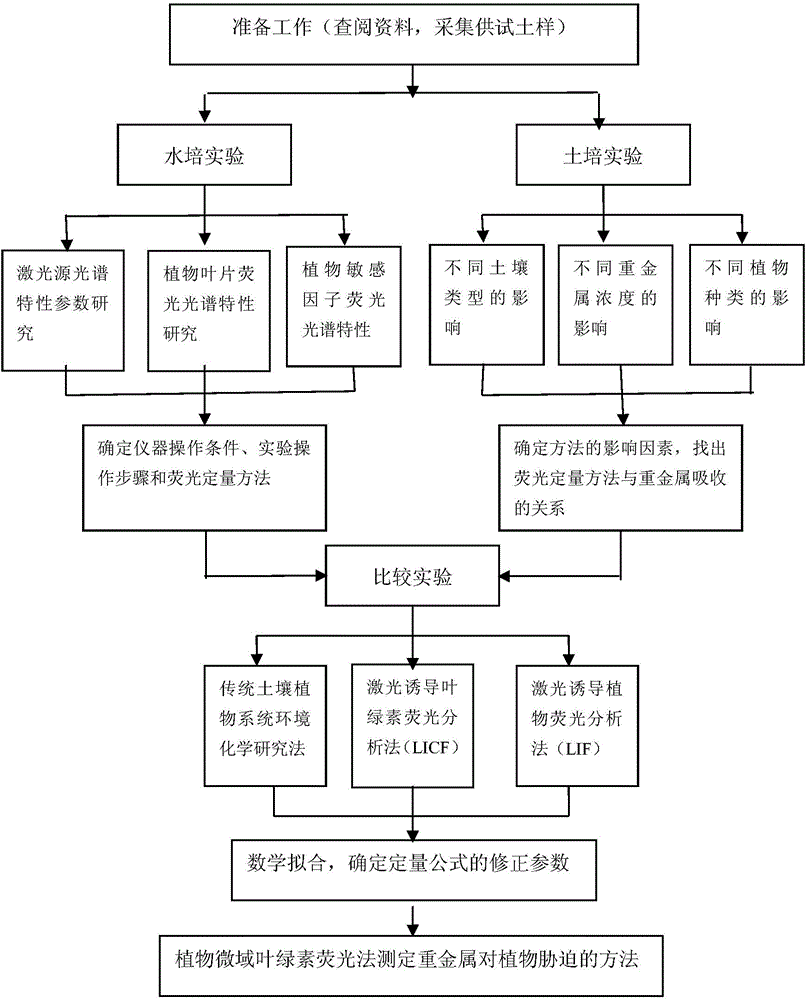Method or measuring stress of heavy metals on plants by using plant micro-domain chlorophyll fluorescence method
A technology for chlorophyll fluorescence and heavy metals, applied in fluorescence/phosphorescence, material excitation analysis, etc., can solve the problems of high experimental conditions, single excitation wavelength, improper operation, etc., and achieve simple measurement process, high optical power density, and external influence small effect
- Summary
- Abstract
- Description
- Claims
- Application Information
AI Technical Summary
Problems solved by technology
Method used
Image
Examples
Embodiment 1
[0014] Example 1: In this example, through cultivation experiments, pot experiments, and comparative experiments, under the condition of not destroying the growth of plants, using a xenon lamp as a laser source, systematically implement laser-induced plant growth in different plants, different heavy metals, and different soils. Spectral characteristics, quantitative methods and influencing factors of fluorescence, the specific implementation process can be found in figure 1 The present embodiment relates to the determination of the spectral characteristics and instrument operating conditions of the xenon lamp excitation light source. Its xenon lamp laser source is at a wavelength of 325nm., and the slit width is 0.05mm. Photoluminescence intensities were recorded at wavelengths from 350 to 800 nm.
Embodiment 2
[0015] Embodiment 2: This embodiment relates to the spectral characteristic parameters of different plant leaves under different heavy metal stresses. The Hoagland nutrient solution is used as the hydroponic nutrient solution, and 0-10.0mg.L is added respectively -1 Cu 2+ (CuSO 4 ), 0-1.0mg.L -1 Cd 2+ (CdCl 2 ), 0-10.0mg.L -1 Zn 2+ (ZnSO 4 ), 0-10.0mg.L -1 of Pb 2+ (PbCl 2 ), simulated heavy metal stress, planted different plants, cultivated in greenhouse (25°C), monitored the pH of the nutrient solution, measured the characteristic parameters of fluorescence spectra of different plants and plant leaves under different heavy metal stress, determined the instrument conditions, the operation steps of the method, and the quantitative Methods: Under the stress of different concentrations of Zn, Cu, Pb or Cd, the fluorescence intensity of plants appeared peaks at 450nm, 690nm and 735nm. The peak heights at 690nm and 750nm decreased with the concentration of heavy metal st...
Embodiment 3
[0016] Example 3: This example involves the use of three fluorescence bands to calculate the stress of heavy metals in soil. In order to find the relationship between the fluorescence intensity and the absorption of heavy metals by plant leaves, the peak heights of the three peaks are used to calculate F450 / F690 , the ratios of F450 / F735, F690 / F735 and F450 / (F690+F735); the three ratios of F450 / F690, F450 / F735 and F450 / (F690+F735) all increased with the increase of heavy metal stress concentration; such as, F450 / F690 increases with the concentration of Cd; F450 / F735 increases with the concentration of Cu; only the ratio of F450 / (F690+F735) increases with the increase of heavy metal stress concentration in the range of leaves and heavy metals used in the experiment ; Therefore, A=F450 / (F690+F735) reflects the degree of plant stress by heavy metals, the greater the value of A, the more serious the stress of heavy metals.
PUM
 Login to View More
Login to View More Abstract
Description
Claims
Application Information
 Login to View More
Login to View More - R&D
- Intellectual Property
- Life Sciences
- Materials
- Tech Scout
- Unparalleled Data Quality
- Higher Quality Content
- 60% Fewer Hallucinations
Browse by: Latest US Patents, China's latest patents, Technical Efficacy Thesaurus, Application Domain, Technology Topic, Popular Technical Reports.
© 2025 PatSnap. All rights reserved.Legal|Privacy policy|Modern Slavery Act Transparency Statement|Sitemap|About US| Contact US: help@patsnap.com

